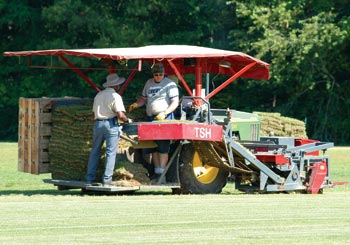In The Green

Alabama’s green industry, often overlooked as part of the state’s agricultural scene, could finally get the recognition it deserves in light of a new Auburn University study. According to the report, the green industry produces the largest cash crop in the state, contributes $1.9 billion annually to Alabama’s economy and provides jobs for almost 31,000 Alabamians.The study–a joint effort by AU, the Alabama Nursery and Landscape Association, the Alabama Turfgrass Association and the U.S. Department of Agriculture–is the first-ever comprehensive economic analysis of the state’s green industry. It includes nursery and greenhouse, turfgrass and sod and lawn and landscaping operations as well as retail businesses that sell plant materials and related products. “Talk about the largest crop in the state, and most people think of cotton,” said AU agricultural economist and study coordinator Deacue Fields. “This study, which was long overdue, clearly illustrates the tremendous and far-reaching impact of the green industry to Alabama.”Brian Hardin of the Alabama Farmers Federation said the Federation’s State Greenhouse, Nursery & Sod Division endorsed the study and contributed funds to help cover the costs.”Many other states have assessed the value of their green industries to better understand their impact. Now, we know the numbers for our industry beyond the farm gate as well,” Hardin said. “This information will help local, state and federal leaders better understand the far-reaching benefits of our greenhouse, nursery and sod producers. Alabama can be proud of this industry’s contributions to its agricultural economy, but also to its economy as a whole.”The study revealed that Alabama’s 767 nurseries and commercial greenhouses contribute almost $306 million to the economy and employ 4,319 workers.Lance Byrd of Shelby County, who chairs the Federation’s Greenhouse, Nursery and Sod State Committee, runs Green Valley Farms in rural Shelby County with wife Dana and father Robert. He said increased development around urban centers has caused the green industry to grow rapidly since his family opened its nursery in 1994.”More government bodies are requiring that people do landscaping, which is requiring more product,” said Byrd. “There is more of a demand for quality products.”Byrd said the study is one way farmers can spread the word about the importance of their industry.”There are fewer and fewer people who are familiar with agriculture,” he said. “The bigger the population gets and the fewer farms you have, the fewer people are seeing what goes on at a farm. I think all different commodities of agriculture need to bring their story to the public eye. There are a lot of people who don’t know where the products they use come from.”In addition to operating a nursery, the Byrds are among the state’s 69 turfgrass and sod operations, which employ 1,030 workers and represent $99 million in total output impact, according to the study.Output impact includes the direct impact from industry sales, indirect impacts from allied firms that supply inputs to the industry and induced effects when the industry’s employees spend their paychecks.Alan Barton and Carole Barton, who operate Barton’s Greenhouse and Nursery in Alabaster, said they have seen the green industry change since opening their business in 1982.”The variety and quality of plants that people are buying are much different now than when we first started,” Alan said. “The emphasis on the commercial and professional landscaping at businesses, shopping malls, universities and public buildings is way beyond what it was when we started.””People have really grown to appreciate the value of their landscape and how it reflects on their business,” added Carole.That renewed appreciation for landscaping was reflected in the study. It found that the lawn and landscape sector, which includes 1,029 state-licensed operators, gives more than 8,500 people jobs and boasts an economic impact of $645.4 million. In addition, some 727 retail establishments selling plants, shrubs and related products employ just under 7,000 Alabamians and have a total output impact of $855.6 million annually. The report also noted that Alabama’s green industry pays $269.4 million in state and local taxes.Nationally, the USDA has identified the green industry as one of the largest and fastest-growing segments of U.S. agriculture. The AU study indicates the same holds true in Alabama.”This study is extremely important because it establishes a benchmark by which we can monitor future growth and progress in the industry,” said Ken Tilt, an AU horticulture professor and Alabama Agricultural Experiment Station researcher who assisted with the study. “Another important point is that it’s one of the few crops that has exhibited consistent growth over the past 10 years in the state and shows continued promise for the future.”When funds are allocated by government and granting agencies for research and extension, hopefully these supporting figures will give these agencies reason to look more closely at our industry,” he said. Byrd said he hopes the study also will make government agencies reconsider before enacting rules that adversely impact the green industry.”A few years ago, when we had a water shortage, some of the water boards in this area decided to stop all outdoor watering. It basically shut the nursery industry down,” he said. “We need a better system in place to allow people to be able to water outside and not kill this industry. Just because you can drive by and see us outside does not make us use anymore water than somebody who is inside running a sink and just leaving it wide open.”Hopefully, through communication and showing people how big of an impact our industry has on the economy, it’ll make them think twice,” Byrd added.Data from the study show Alabama ranks third in the nation in turfgrass and sod production and 16th in nursery and greenhouse production.
